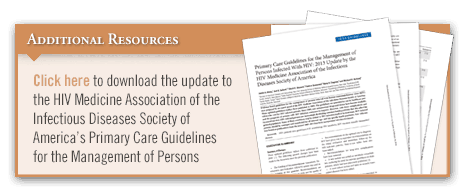According to the CDC, nearly 1.2 million Ameri-cans are living with HIV and about 50,000 people in the United States are infected with the virus each year. Studies have estimated that as many as 80% of patients with HIV have their virus under control and live long, full lives. “With HIV continuing to become a manageable but complex chronic disease, HIV specialists and primary care physicians (PCPs) now need to provide the full spectrum of healthcare to these patients,” says Michael A. Horberg, MD, MAS, FACP, FIDSA. “PCPs and other healthcare providers need a better grasp of the impact that HIV care has on routine healthcare.”
A Helpful Update
In 2009, an expert panel of the HIV Medicine Association of the Infectious Diseases Society of America (IDSA) released evidence-based guidelines for the management of people infected with HIV. Recently, these guidelines were updated to replace the 2009 recommendations and published in Clinical Infectious Diseases. Since 2009, new antiretroviral drugs and classes have become available, and the prognosis of people with HIV infection continues to improve. The guideline update also incorporates new information based on publications from 2009 to 2013.
“The updated IDSA guidelines are intended for use by healthcare providers who care for HIV-infected patients,” says Dr. Horberg, who was on the expert panel that developed the update. “These new recommendations reflect the fact that people with HIV are now living much more normal life spans. As such, there is a greater need to focus on preventive care, including screening for high cholesterol, diabetes, osteoporosis, depression, and substance abuse, among other health conditions.”
Although there are better survival rates, people with HIV are increasingly developing common health problems that also affect the general population. Some of these conditions may be related to HIV infection itself or its treatment. “An important theme of the guidelines is that HIV-infected patients be managed and monitored for all relevant age- and sex-specific health problems,” Dr. Horberg says.
Summarizing Key Changes
The guidelines have expanded recommendations on the initial evaluation and immediate follow-up for HIV-infected patients. Patients whose infection is under control for some time can have their HIV blood levels monitored every 6 to 12 months, rather than every 3 to 4 months as previously recommended (Table 1). In addition, the guidelines include new recommendations on screening for diabetes, osteoporosis, and colon cancer. They also suggest that patients with HIV infection be vaccinated against pneumococcal infection, influenza, varicella, and hepatitis A and B. “HIV may be under control in many patients, but we still should stress the importance of preventing other health problems,” adds Dr. Horberg. “This requires taking a holistic approach to care.”
The IDSA’s guideline update has added easy-to-use tables that outline interactions between specific antiretroviral drugs and statins. Importantly, a new section on metabolic comorbidities was added to the guidelines, replacing the need for separate recommendations on dyslipidemia, which had been previously published (Table 2). There also is a more robust section on sexually transmitted diseases, including a recommendation for annual screening of trichomoniasis in women and yearly screening for gonorrhea and chlamydia for patients considered to be at risk.
Behavior Matters
“The guidelines stress that physicians should consistently discuss and counsel patients on their sexual history and any risky behaviors, such as using illicit drugs,” Dr. Horberg says. “We need to do this in a non-judgmental manner. We also need to determine how well patients are coping with living with HIV and if they have a sufficient support network.” General messages about risk reduction should be provided at all healthcare encounters—regardless of risk behaviors—by providers, others in healthcare, or with educational materials (eg, pamphlets, posters, and videos). Tailored messages are critical, especially for patients persistently reporting high-risk behaviors. Referrals to programs capable of offering more extensive interventions are also important.
When HIV is under control, patients often feel that they do not need to see their physicians regularly. Dr. Horberg says adherence is about more than just taking HIV medications on a regular basis. “It’s also about receiving regular primary care,” he says. “HIV specialists and PCPs alike need to be familiar with these issues so that we can bridge treatment gaps in HIV care. These guidelines are designed to help ensure that patients with HIV live long and healthy lives. Hopefully, we can learn more about methods for further enhancing our ability to take a holistic approach to caring for patients infected with HIV.”




 admin
admin